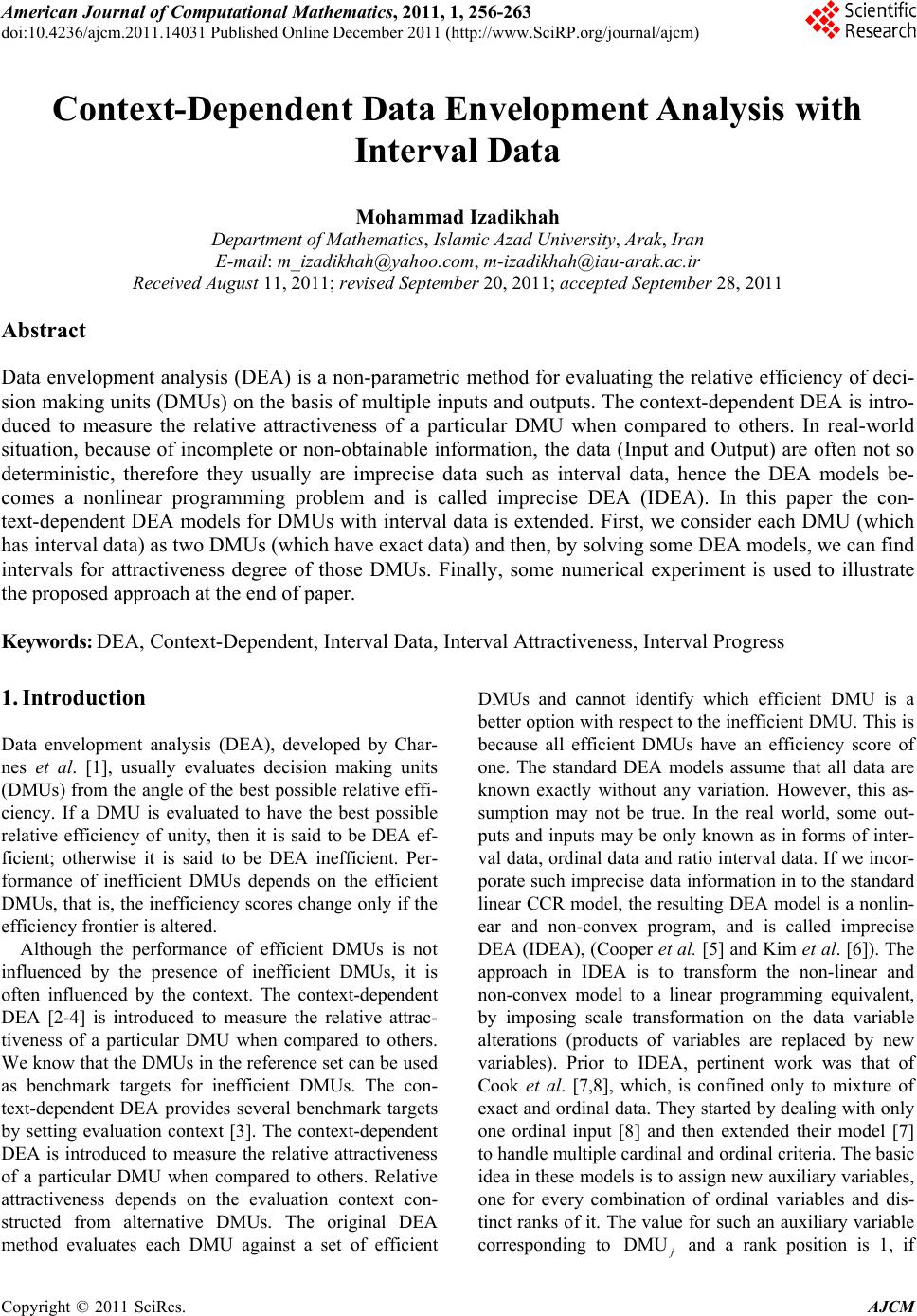 American Journal of Computational Mathematics, 2011, 1, 256-263 doi:10.4236/ajcm.2011.14031 Published Online December 2011 (http://www.SciRP.org/journal/ajcm) Copyright © 2011 SciRes. AJCM Context-Dependent Data Envelopment Analysis with Interval Data Mohammad Izadikhah Department of Mat hematics, Islamic Azad University, Arak, Iran E-mail: m_izadikhah@yahoo.com, m-izadikhah@iau-arak.ac.ir Received August 11, 2011; revised Septembe r 20, 2011; accept ed September 28, 2011 Abstract Data envelopment analysis (DEA) is a non-parametric method for evaluating the relative efficiency of deci- sion making units (DMUs) on the basis of multiple inputs and outputs. The context-dependent DEA is intro- duced to measure the relative attractiveness of a particular DMU when compared to others. In real-world situation, because of incomplete or non-obtainable information, the data (Input and Output) are often not so deterministic, therefore they usually are imprecise data such as interval data, hence the DEA models be- comes a nonlinear programming problem and is called imprecise DEA (IDEA). In this paper the con- text-dependent DEA models for DMUs with interval data is extended. First, we consider each DMU (which has interval data) as two DMUs (which have exact data) and then, by solving some DEA models, we can find intervals for attractiveness degree of those DMUs. Finally, some numerical experiment is used to illustrate the proposed approach at the end of paper. Keywords: DEA, Context-Dependent, Interval Data, Interval Attractiveness, Interval Progress 1. Introduction Data envelopment analysis (DEA), developed by Char- nes et al. [1], usually evaluates decision making units (DMUs) from the angle of the best possible relative effi- ciency. If a DMU is evaluated to have the best possible relative efficiency of unity, then it is said to be DEA ef- ficient; otherwise it is said to be DEA inefficient. Per- formance of inefficient DMUs depends on the efficient DMUs, that is, the inefficiency sco res change only if the efficiency frontier is altered. Although the performance of efficient DMUs is not influenced by the presence of inefficient DMUs, it is often influenced by the context. The context-dependent DEA [2-4] is introduced to measure the relative attrac- tiveness of a particular DMU when compared to others. We know that the DMUs in the reference set can be used as benchmark targets for inefficient DMUs. The con- text-dependent DEA provides several benchmark targets by setting evaluation context [3]. The context-dependent DEA is introduced to measure the relative attractiveness of a particular DMU when compared to others. Relative attractiveness depends on the evaluation context con- structed from alternative DMUs. The original DEA method evaluates each DMU against a set of efficient DMUs and cannot identify which efficient DMU is a better option with respect to the inefficient DMU. This is because all efficient DMUs have an efficiency score of one. The standard DEA models assume that all data are known exactly without any variation. However, this as- sumption may not be true. In the real world, some out- puts and inputs may be only known as in forms of inter- val data, ordinal data and ratio interval data. If we incor- porate such imprecise data information in to the standard linear CCR model, the resulting DEA model is a nonlin- ear and non-convex program, and is called imprecise DEA (IDEA), (Cooper et al. [5] and Kim et al. [6]). Th e approach in IDEA is to transform the non-linear and non-convex model to a linear programming equivalent, by imposing scale transformation on the data variable alterations (products of variables are replaced by new variables). Prior to IDEA, pertinent work was that of Cook et al. [7,8], which, is confined only to mixture of exact and ordinal data. They started by dealing with only one ordinal input [8] and then extended their model [7] to handle multiple cardinal and ordinal criteria. The basic idea in these models is to assign new auxiliary variables, one for every combination of ordinal variables and dis- tinct ranks of it. The value for such an auxiliary variable corresponding to DMU and a rank position is 1, if  M. IZADIKHAH257 DMU is rated in the k-th place of ordinal variable and 0 otherwise. Extensions of these basic ideas are reported in [9,10]. Recently, Despotits and Smirlis [11] calculated upper and lower bounds for the efficiency scores of the DMUs with imprecise data. They developed an alterna- tion approach for dealing with imprecise data. They transformed the non-linear DEA model to a linear pro- gramming equivalent by using a straightforward formu- lation, completely different than that in IDEA. Contrarily to IDEA their transformation on the variables are made on the basis of the original data set, without applying any scale transformations on data. Also, in Jahanshahloo et al. [12,13] the radius of stability for the DMUs with interval data is calculated. In this paper we concentrate on the context-dependent DEA with interval data. For this rea- son we consider each DMU , with interval data, as two DMUs that have exact data. Then by a procedure similar to that one in [3], the evaluation contexts are obtained by partitioning these DMUs into several levels of efficient frontier. Then by introducing some models based upon these efficient frontiers we can measure the relative at- tractiveness and progress of these DMUs and also we can determine the interval attractiveness and interval pro- gress for each original DMU with interval data. Further by combination of these measures we can also character- ize the performance of DMUs. The rest of the paper is organized as follows: next sec- tion introduces the basic definitions of interval data and notations of the original context-dependent DEA. In Sec- tion 3, interval context-dependent DEA is presented. In Section 4 we illustrate our proposed DEA method with two numerical examples and some discussion. Finally, some conclusions are pointed out in the end of this paper. 2. Preliminaries Now suppose we have DMUs which utilize in- puts n m ,1,, ij imto produce outputs rj ,1,,, 1,, rs 1 jn ,, . Also, assume that input and output levels of each DMU are not known exactly. We define jmj xx and 1,, jsj Yy y, . 1, ,jn 2.1. Interval Data Let input and output values of any DMU be located in a certain interval, where ij and U ij are the lower and upper bounds of the i-th input of the DMU , respecti- vely, and rj y, are the lower and upper bounds of the r-th output of the U rj yDMU , respectively, that is to say, U ijij ij xx and U ry j rj yy rj . Such data are called interval data, because they are located in intervals. Note that always U ij ij x and U rj y rj y. If U ijij x, then the i-th input of the DMU has a definite value. Interval problems are those whose parameter values are located in intervals, their exact values being unable to be identified. Therefore we consider problems with data such as , LU ijij ij xx and rj rj , LU y rj yy , where lower and upper bounds are known exactly, positive and finite. 2.2. Context-Dependent Data Envelopment Analysis with Exact Data The original context-dependent DEA model is developed by using the following radial efficiency measure. Let 1 be the set of all DMUs, and k and interactively defined as k E 1kkk IE , where consists of all the radially efficient DMUs by following linear program- ming: k E * 0 0 .. oo jj jj o k kk stX X Yk jFE () () max 0, k k jFI jFI j Y (1) where k jFI means DMU k j E . When k = 1, model (1) becomes the original output oriented CCR model and define the first-level efficient frontier. When k = 2, model (1) gives the second-level efficient frontier after the exclusion of the first-level efficient DMUs. And so on. In this manner we identify several levels of efficient frontiers. We call the k-th level efficient frontier. 1 E k Assume that, , 0. We can calculate relative attractiveness measures for with respect to k-th level efficient frontier. Based upon the evaluation context , relative attractiveness meas- ure of o can obtained by the following con- text-dependent DEA: 0 k k E DMUoE k E 0 1, ,kn DMUo DMU 0 0 () () ax 0, kk kk oo E E 0 *0 0 0 m 1,...,- .. jj jF jj o jF kk j kH X kkL st X YHkY jFE k (2) Then ** o 1 o kHk DMUo 0, ,k k is called the (output oriented) attractiveness of from a specific level . k E Model (2) is same as [3] with slightly change. In model (2) we set 0 L in order to consider- ing as evaluation context for . 0 k E0 DMU k oE Note: In this paper, only, attractiveness measure is used. By the same mann er one can use progress m easure Copyright © 2011 SciRes. AJCM 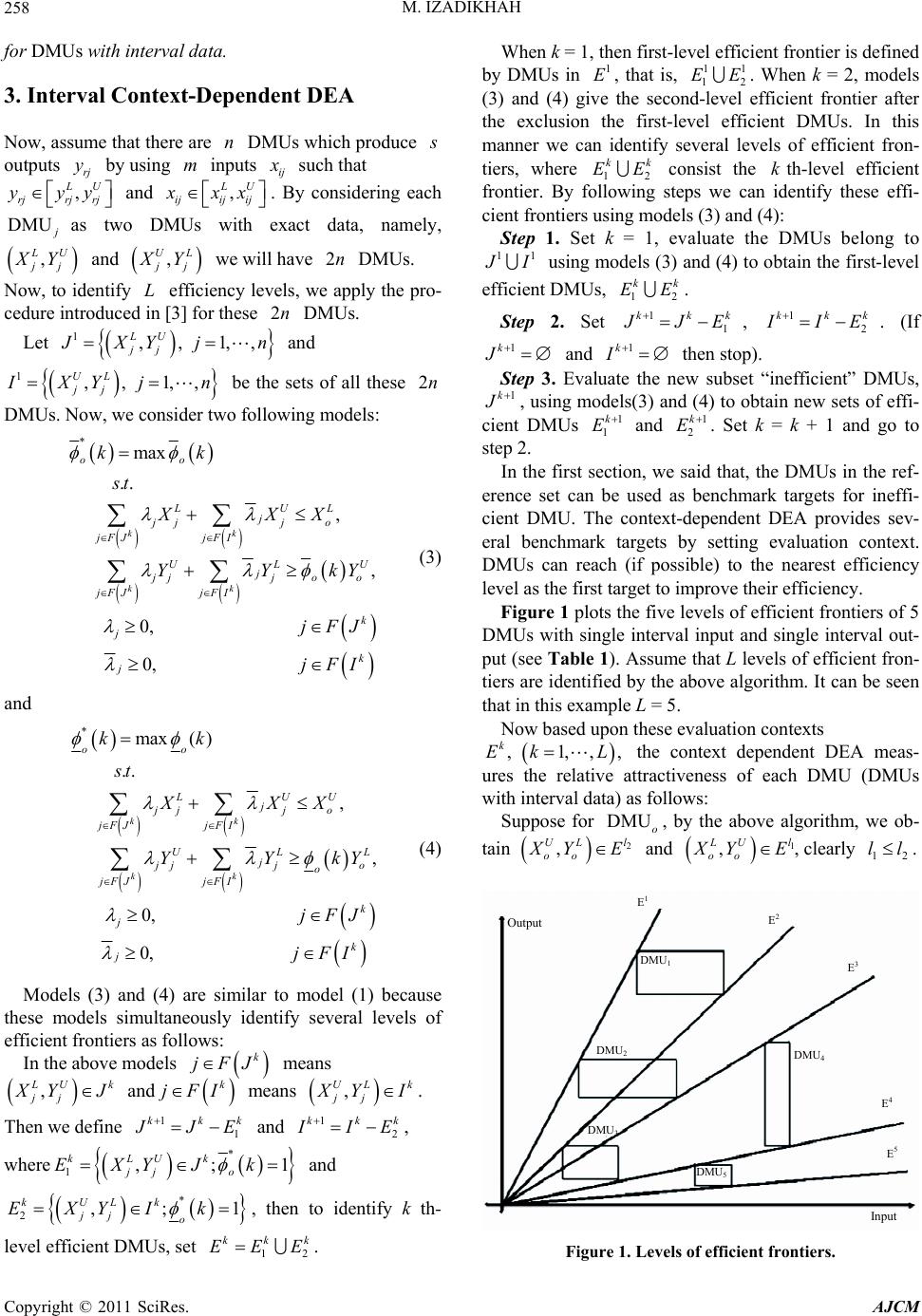 M. IZADIKHAH 258 for DMUs with interval data. 3. Interval Context-Dependent DEA Now, assume that there are DMUs which produce n outputs by using inputs rj ymij such that ,U rjrj rj yyy L and , LU ijij ij xx . By considering each DMU as two DMUs with exact data, namely, U , L jj Y and , UL j Y we will have DMUs. 2n Now, to identify efficiency levels, we apply the pro- cedure introduced in [3] for these DMUs. L2n Let 1,, 1,, LU jj XY jn ,, 1,, UL jj and 1 XY jn be the sets of all these DMUs. Now, we consider two following models: 2n *max .. , , 0, 0, kk kk oo LUL j jjj o jFJjFI UL jo jjj o jFJjFI k j j kk st XXX YYk jFJ k jFI U Y (3) and *max() .. , , 0, 0, kk kk oo LUU j jjj o jFJjFI UL jL jj o jFJjFI k j j kk st XXX YYk jFJ k jFI o Y (4) Models (3) and (4) are similar to model (1) because these models simultaneously identify several levels of efficient frontiers as follows: In the above models k jFJ means , U jj k YJ and means k jFI , UL k jj YI . Then we define 11 kkk JE and 12 kkk IE , where * 1,; kLUk o jj EXYJk 1 and * 2,; kULk jj o EXYIk 1 k 1 k 1 , then to identify k th- level efficient DMUs, set . 12 kk EEE When k = 1, then first-level efficient frontier is defined by DMUs in , that is, 2 . When k = 2, models (3) and (4) give the second-level efficient frontier after the exclusion the first-level efficient DMUs. In this manner we can identify several levels of efficient fron- tiers, where 12 consist the th-level efficient frontier. By following steps we can identify these effi- cient frontiers using models (3) and (4): 1 E E 1 1 EE k Ek Step 1. Set k = 1, evaluate the DMUs belong to 1 I using models (3) and (4) to obtain the first-level efficient DMUs, . 12 kk EE Step 2. Set 11 kkk JE , 12 kkk IE . (If 1k J and 1k I then stop). Step 3. Evaluate the new subset “inefficient” DMUs, 1k , using models(3) and (4) to obtain new sets of effi- cient DMUs 1 1 k E and . Set k = k + 1 and go to step 2. 1 2 k E In the first section, we said that, the DMUs in the ref- erence set can be used as benchmark targets for ineffi- cient DMU. The context-dependent DEA provides sev- eral benchmark targets by setting evaluation context. DMUs can reach (if possible) to the nearest efficiency level as the first target to improve their efficiency. Figure 1 plots the five levels of efficient frontiers of 5 DMUs with single interval input and single interval out- put (see Table 1). Assume th at L levels of efficient fron- tiers are identified by the above algorithm. It can be seen that in this example L = 5. Now based upon these evaluation contexts , 1,,, k Ek L the context dependent DEA meas- ures the relative attractiveness of each DMU (DMUs with interval data) as follows: Suppose for , by the above algorithm, we ob- DMUo tain 2 , UL oo l YE and 1 ,l LU oo YE, clearly 12 ll . Output DMU2 DMU1 DMU3 DMU5 DMU4 E4 E5 E3 E2 E1 Input Figure 1. Levels of efficient frontiers. Copyright © 2011 SciRes. AJCM  M. IZADIKHAH259 Table 1. Data of numerical example. DMUj Inputs j U j Outputs j y U j y 1 3.5 6 6 7 2 2.1 5 3 4.2 3 1.5 3 0.6 1.5 4 7.5 8 1.6 4.5 5 5 6 0.5 1 Now, we introduce two following context dependent DEA models to obtain the relative attractiveness meas- ure. 22 12 22 12 2 * 2 1 max, 0,, .. , , 0, 0, kl kl kl kl oo LUL j jjj o jFEjFE UL o j jjj o jFEjFE kl j j HkHkk Ll st XXX YYH jFE 2 2 kl jFE U kY (5) and 22 12 22 12 2 *2 1 max,0,, .. , , 0, 0, kl kl kl kl oo LUU j jjj o jFEjFE UL jo jjj o jFEjFE kl j j HkHkk Ll st XXX YYH jFE 2 2 kl jFE L kY (6) Clearly, *1 o Hk and *1 o Hk for 2 0,, kLl , and also, * 1 o* o kH k and ** 1 oo kH k. Theorem 1. For we have DMUo **, oo kHk 2 Proof. First assume that 0, ,.kLl * * ,, o Hk * be optimal solution for model (5). Thus we have 22 12 klkl ULUL oo j jjoo jFEjFE YYHkYHkY therefore * * ,, o Hk * is a feasible solution for model (6). Since model (6) is maximization and has an optimal value as * o k, then ** oo kHk. Corollary 1. If DMU , Y has exact data, where U oo XX and U o YYY o , then we must have ** *2 ,,0,, oo kHkHkk L l , where * k is the relative attractiveness measure for DMU . Assume that has interval data, that is, DMUo U o , L oo XXX and , LU ooo YYY . By Corollary 1, ** *2 ,,0,, oo. kHkHkk Ll Definition 1. If we call k-degree attractiveness of (which is lie on the specific level DMUo ll 22 1 EEE2 2 l ) by * o k, then we h ave *** 11 , o oo Ak Hk k . That is, attractiveness score of with respect to efficiency level is DMUok E * o k. Definition 2. We define ** 11 , oo Hk k as k-de- gree attractiveness of . DMUo Since th e parameter v alues are located in intervals and their exact values being unable to be identified, hence value of * o k is unknown. Also, one can rank the DMUs in each level based upon their attractiveness scores. 4. Application In order to illustrate the use of the methodology for de- termining the interval attractiveness developed here, first, in example 1 we use the data in Table 1 and in example 2 we use an empirical data. 4.1. Example 1: Personal Selection Data Assume that, we have 5 DMUs in one input and one output and these data are interval as shown in Table 1. By considering each DMU as two DMUs with exact data, namely, U jj , L Y and , UL j Y we will have 10 DMUs. Now, to identify the efficient levels of these DMUs, we apply models (3) and (4). Results are shown below: 111 22 ,,, LU LU EXYXY 21133 ,,, UL LU EXYXY 322 44 ,,, UL LU EXYXY 433 44 55 ,, ,,, UL ULLU EXYXYXY 555 , UL EXY Copyright © 2011 SciRes. AJCM  M. IZADIKHAH 260 We see that for these DMUs, 5 efficient levels are identified, i.e., = 5. By models (5) and (6), interval attractiveness of each DMU can be calculated. In Table 2 interval attractiveness of each original DMUs (which have interval data) are shown in column 4. For example, in Table 2, first-degree interval attractiveness of with respect to efficiency level is [1.67, 3.33]. L 1 DMU 3 E That is, if we choose exact value for input and output of and then calculate the attractiveness degree of 1 with respect to efficiency level , namely , we must have . 1 DMU DMU (3) 3 E * 1 A* 1 1.67(3)3.33A Discussion In the above mentioned example, suppose that, we fix the data of these DMUs in their intervals, in th e other words, assume that we have 5 DMUs, namely, DMU,, 1,,5, jj jXY j which have exact data such that , LU j j XXX , , LU jjj YYY . These data are as Table 3. We will show that, the attractiveness score of these DMUs lies in the interval attractiveness presented in Ta- Table 2. Interval attractiveness. DMUj k-degree Efficiency Levels k-degree inte rval attractiveness 1 Zero-degree 2 E [1,2] First-degree 3 E [1.67,3.33] Second-degree 4 E [5,10] Third-degree 5 E [12,24] 2 Zero-degree 3 E [1,3.33] First-degree 4 E [3,10] Second-degree 5 E [7.2,24] 3 Zero-degree 4 E [1,5] First-degree 5 E [2.4,12] 4 Zero-degree 4 E [1,3] First-degree 5 E [2.4,7.2] 5 Zero-degree 5 E [1,2.4] Table 3. DMUs with exact data. DMUj Input Output 1 5 6 2 3 4 3 2 1 4 7.5 4.5 5 6 0.5 ble 2. Hence, we employ models (3) and (4) for these DMUs. Let k E be the th-level of efficient frontier. See Figure 2 and compare kk E and . k E We define k SE as follows: 11 ,,,0,, k nn k jjjj jjj jj SE yxX yYXYE For example, Figure 3 illustrates region of k SE . It can be seen that, 54 54 3 321 21 SE SESESESE SESE SE SESE Assume that, we want to calculate the attractiveness degree of 1 DMU with respect to efficiency level 4 E, that is, we want to calculate . Since * 14A2 1 DMU E and 4 34 SE SESE, hence the attractiveness Output Input DMU 1 DMU 2 DMU 3 DMU 5 DMU 4 1 3 4 5 5 3 2 1 4 1 2 2 3 5 Figure 2. Levels of efficient froutiers for DMUs with exact data and interval data. Output Input 3 3 SE Figure 3. Region of 3 E. Copyright © 2011 SciRes. AJCM 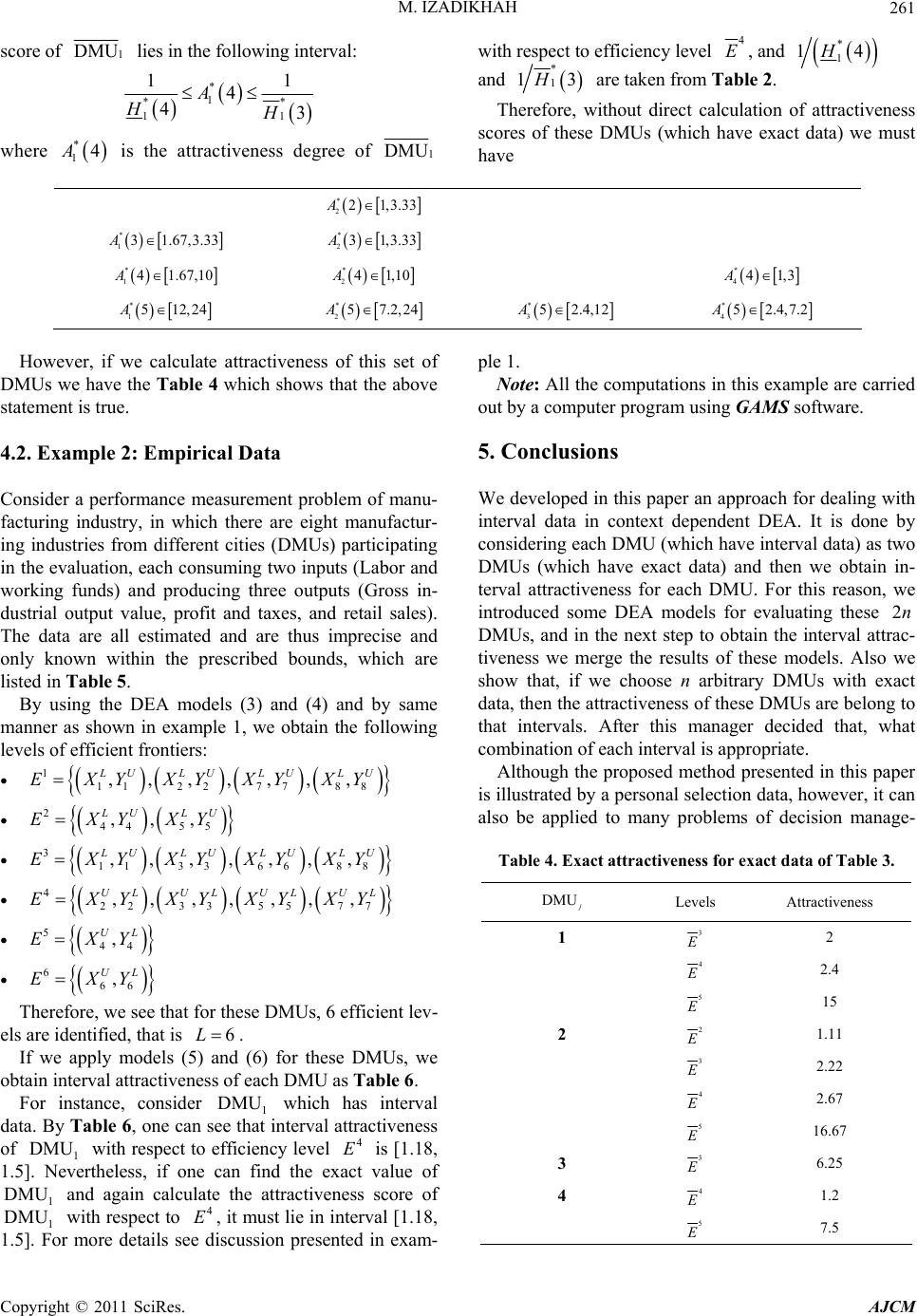 M. IZADIKHAH Copyright © 2011 SciRes. AJCM 261 with respect to efficiency level 4 E, and * 1 14H score of 1 DMU lies in the following interval: and * 1 13H are taken from Table 2. * 1 ** 11 11 4 43 A HH Therefore, without direct calculation of attractiveness scores of these DMUs (which have exact data) we must have where is the attractiveness degree of * 14A1 DMU * 221,3.33A * 13 1.67,3.33A * 231,3.33A * 141.67,10A * 241,10A * 441,3A * 1512,24A * 257.2,24A * 352.4,12A * 452.4,7.2A However, if we calculate attractiveness of this set of DMUs we have the Table 4 which shows that the above statement is true. 4.2. Example 2: Empirical Data Consider a performance measurement problem of manu- facturing industry, in which there are eight manufactur- ing industries from different cities (DMUs) participating in the evalua tion, each consuming two inputs ( Labor and working funds) and producing three outputs (Gross in- dustrial output value, profit and taxes, and retail sales). The data are all estimated and are thus imprecise and only known within the prescribed bounds, which are listed in Table 5. By using the DEA models (3) and (4) and by same manner as shown in example 1, we obtain the following levels of efficient frontiers: 11122 77 88 ,,,,,,, LU LU LU LU E XYXYXYXY 244 55 ,,, LULU EXYXY 31133 66 88 ,,,,,,, LU LU LU LU E XYXYXYXY 422 33 55 77 ,, ,, ,, , UL ULULUL E XYXYXYXY 544 , UL EXY 666 , UL EXY Therefore, we see that for these DMUs, 6 efficient lev- els are identified, that is . 6L If we apply models (5) and (6) for these DMUs, we obtain interval attractiveness of each DMU as Table 6. For instance, consider 1 which has interval data. By Table 6, one can see that interval attractiveness of 1 with respect to efficiency level is [1.18, 1.5]. Nevertheless, if one can find the exact value of and again calculate the attractiveness score of 1 with respect to , it must lie in interval [1.18, 1.5]. For more details see discussion presented in exam- ple 1. DMU 4 DMU 1 DMU DMU 4 E E Note: All the computations in this example are carried out by a computer program using GAMS software. 5. Conclusions We developed in this paper an approach for dealing with interval data in context dependent DEA. It is done by considering each DMU (which have interval data) as two DMUs (which have exact data) and then we obtain in- terval attractiveness for each DMU. For this reason, we introduced some DEA models for evaluating these DMUs, and in the next step to obtain the interval attrac- tiveness we merge the results of these models. Also we show that, if we choose n arbitrary DMUs with exact data, then the attractiveness of th ese DMUs are belong to that intervals. After this manager decided that, what combination of each interval is appropriate. 2n Although the proposed method presented in this paper is illustrated by a personal selectio n data, however, it can also be applied to many problems of decision manage- Table 4. Exact attractiveness for exact data of Table 3. DMUj Levels Attractiveness 1 3 E 2 4 E 2.4 5 E 15 2 2 E 1.11 3 E 2.22 4 E 2.67 5 E 16.67 3 3 E 6.25 4 4 E 1.2 5 E 7.5 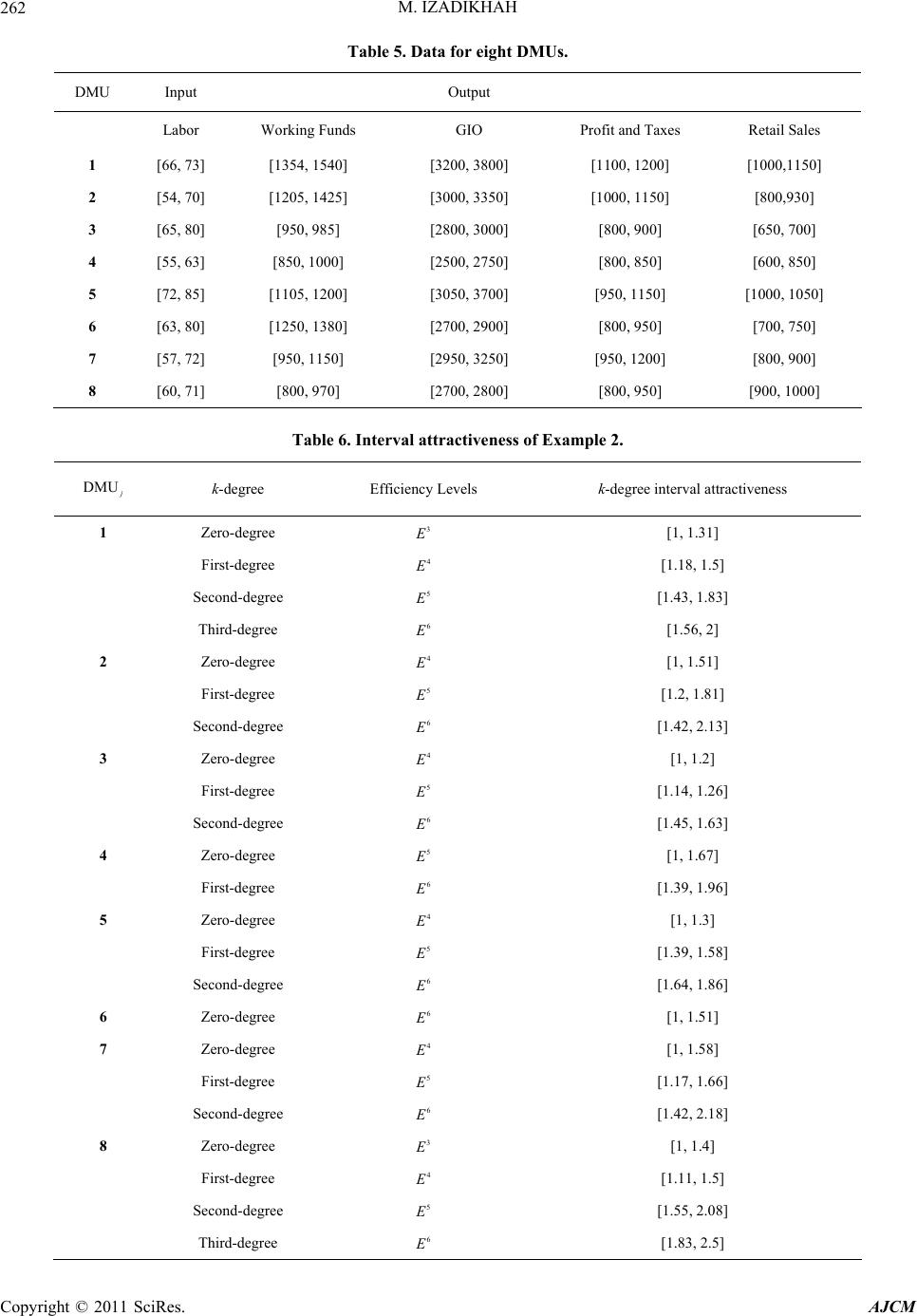 M. IZADIKHAH Copyright © 2011 SciRes. AJCM 262 Table 5. Data for eight DMUs. DMU Input Output Labor Working Funds GIO Profit and Taxes Retail Sales 1 [66, 73] [1354, 1540] [3200, 3800] [1100, 1200] [1000,1150] 2 [54, 70] [1205, 1425] [3000, 3350] [1000, 1150] [800,930] 3 [65, 80] [950, 985] [2800, 3000] [800, 900] [650, 700] 4 [55, 63] [850, 1000] [2500, 2750] [800, 850] [600, 850] 5 [72, 85] [1105, 1200] [3050, 3700] [950, 1150] [1000, 1050] 6 [63, 80] [1250, 1380] [2700, 2900] [800, 950] [700, 750] 7 [57, 72] [950, 1150] [2950, 3250] [950, 1200] [800, 900] 8 [60, 71] [800, 970] [2700, 2800] [800, 950] [900, 1000] Table 6. Interval attractiveness of Example 2. DMUj k-degree Efficiency Levels k-degree interval attractiveness 1 Zero-degree 3 E [1, 1.31] First-degree 4 E [1.18, 1.5] Second-degree 5 E [1.43, 1.83] Third-degree 6 E [1.56, 2] 2 Zero-degree 4 E [1, 1.51] First-degree 5 E [1.2, 1.81] Second-degree 6 E [1.42, 2.13] 3 Zero-degree 4 E [1, 1.2] First-degree 5 E [1.14, 1.26] Second-degree 6 E [1.45, 1.63] 4 Zero-degree 5 E [1, 1.67] First-degree 6 E [1.39, 1.96] 5 Zero-degree 4 E [1, 1.3] First-degree 5 E [1.39, 1.58] Second-degree 6 E [1.64, 1.86] 6 Zero-degree 6 E [1, 1.51] 7 Zero-degree 4 E [1, 1.58] First-degree 5 E [1.17, 1.66] Second-degree 6 E [1.42, 2.18] 8 Zero-degree 3 E [1, 1.4] First-degree 4 E [1.11, 1.5] Second-degree 5 E [1.55, 2.08] Third-degree 6 E [1.83, 2.5] 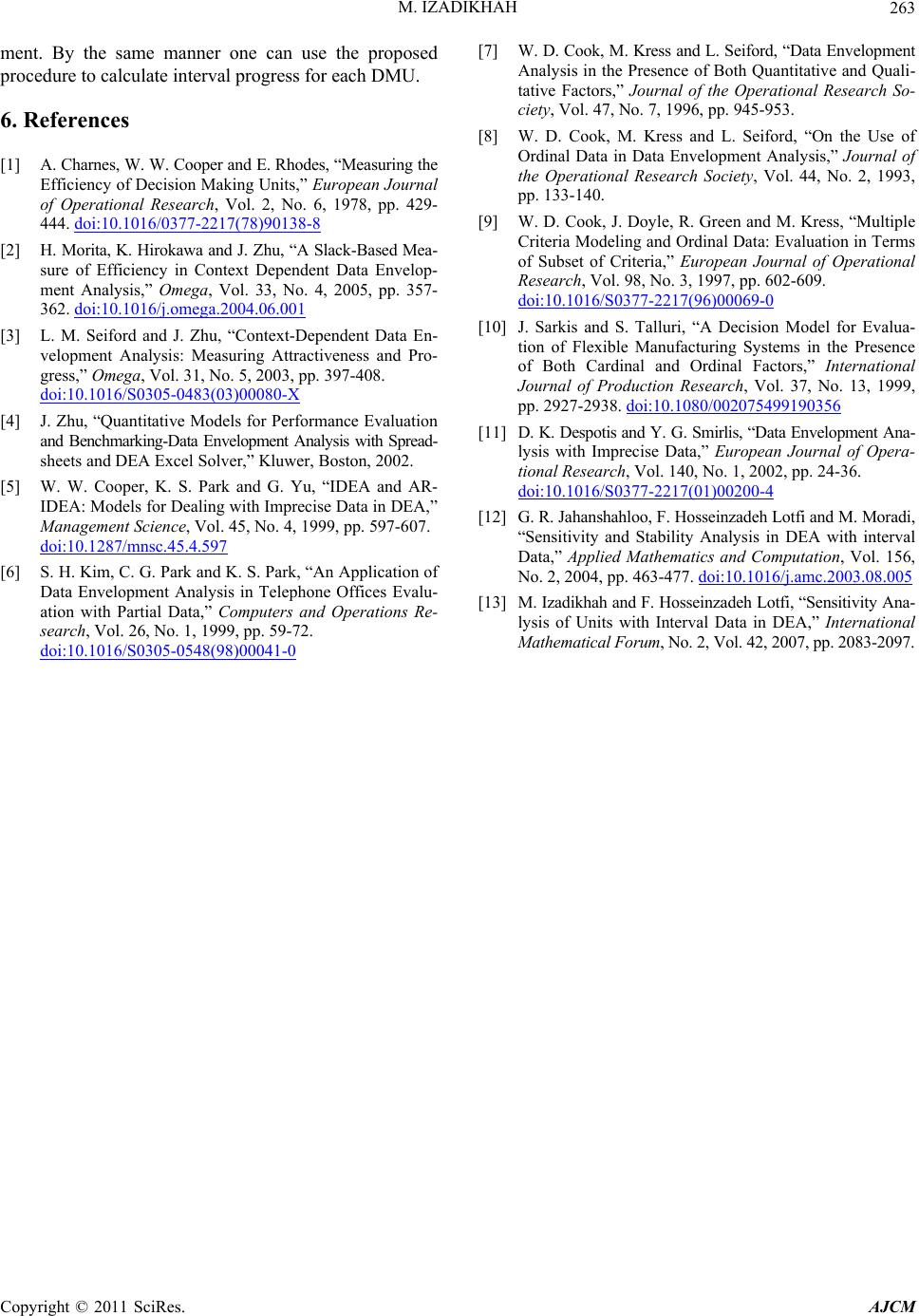 M. IZADIKHAH Copyright © 2011 SciRes. AJCM 263 ment. By the same manner one can use the proposed procedure to calculate interval progress for each DMU. 6. References [1] A. Charnes, W. W. Cooper and E. Rhodes, “Measuri ng the Efficiency of Decision Making Units,” European Journal of Operational Research, Vol. 2, No. 6, 1978, pp. 429- 444. doi:10.1016/0377-2217(78)90138-8 [2] H. Morita, K. Hirokawa an d J. Zhu, “A Slack-Based Mea- sure of Efficiency in Context Dependent Data Envelop- ment Analysis,” Omega, Vol. 33, No. 4, 2005, pp. 357- 362. doi:10.1016/j.omega.2004.06.001 [3] L. M. Seiford and J. Zhu, “Context-Dependent Data En- velopment Analysis: Measuring Attractiveness and Pro- gress,” Omega, Vol. 31, No. 5, 2003, pp. 397-408. doi:10.1016/S0305-0483(03)00080-X [4] J. Zhu, “Quantitative Models for Performance Evaluation and Benchmarking-Data Envelopment Analysis with Spread- sheets and DEA Excel Solver,” Kluwer, Boston, 2002. [5] W. W. Cooper, K. S. Park and G. Yu, “IDEA and AR- IDEA: Models for Dealing with Imprecise Data in DEA,” Management Science, Vol. 45, No. 4, 1999, pp. 597-607. doi:10.1287/mnsc.45.4.597 [6] S. H. Kim, C. G. Park and K. S. Park, “An Application of Data Envelopment Analysis in Telephone Offices Evalu- ation with Partial Data,” Computers and Operations Re- search, Vol. 26, No. 1, 1999, pp. 59-72. doi:10.1016/S0305-0548(98)00041-0 [7] W. D. Cook, M. Kress and L. Seiford, “Data Envelopment Analysis in the Presence of Both Quantitative and Quali- tative Factors,” Journal of the Operational Research So- ciety, Vol. 47, No. 7, 1996, pp. 945-953. [8] W. D. Cook, M. Kress and L. Seiford, “On the Use of Ordinal Data in Data Envelopment Analysis,” Journal of the Operational Research Society, Vol. 44, No. 2, 1993, pp. 133-140. [9] W. D. Cook, J. Doyle, R. Green and M. Kress, “Multiple Criteria Modeling and Ordinal Data: Evaluation in Terms of Subset of Criteria,” European Journal of Operational Research, Vol. 98, No. 3, 1997, pp. 602-609. doi:10.1016/S0377-2217(96)00069-0 [10] J. Sarkis and S. Talluri, “A Decision Model for Evalua- tion of Flexible Manufacturing Systems in the Presence of Both Cardinal and Ordinal Factors,” International Journal of Production Research, Vol. 37, No. 13, 1999, pp. 2927-2938. doi:10.1080/002075499190356 [11] D. K. Despotis and Y. G. Smirlis, “Data Envelopment Ana- lysis with Imprecise Data,” European Journal of Opera- tional Research, Vol. 140, No. 1, 2002, pp. 24-36. doi:10.1016/S0377-2217(01)00200-4 [12] G. R. Jahanshahloo, F. Hosse inzadeh Lotfi and M. Moradi, “Sensitivity and Stability Analysis in DEA with interval Data,” Applied Mathematics and Computation, Vol. 156, No. 2, 2004, pp. 463-477. doi:10.1016/j.amc.2003.08.005 [13] M. Izadikhah and F. Hosseinzadeh Lotfi, “Sensitivity Ana- lysis of Units with Interval Data in DEA,” International Mathematical Forum, No. 2, Vol. 42, 2007, pp. 2083-2097.
|